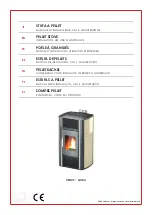
Page 13
6. Important Notes
Problem solving guide
—before calling for technical support
There is no gas:
Main gas valve is closed.
Open the gas valve.
Gas pipe is bent.
Ensure the gas pipe has
been properly fitted.
Burners are not burning properly or at all:
Burners are dirty.
Clean burner components.
Burners are wet.
Dry the burner
components.
Burner cap is not mounted
safely.
Mount the burner cap
properly.
Gas valve is closed.
Open gas valve.
Gas cylinder is empty
(when using LPG).
Replace the gas cylinder.
The burners will not light:
The gas pipe is twisted,
bent or kinked.
Ensure the gas pipe has
been properly fitted.
The burners are dirty or
wet.
Clean / dry the burner
components.
The gas cylinder is empty.
Replace the gas cylinder.
The burner caps are not
fitted correctly.
Fit the burner caps
correctly.
The gas pressure
regulator is closed.
Check to see if the
regulator is open.
Lighting procedure not
been correctly followed.
Follow the correct lighting
procedure.
The flame is yellow, pots and pans are stained:
The burners are dirty or
wet.
Clean / dry the burner
components.
The gas is running out.
Replace the gas cylinder.
The burner caps are not
fitted properly.
Fit the burner caps
properly.
The gas pipe is twisted,
bent or kinked.
Ensure the gas pipe has
been properly fitted.
Smell of leaking gas:
Smell of leaking gas:
Are all the control knobs in
the off position?
Check to see the knobs
are in the off position.
The gas pipe is fitted
incorrectly.
Ensure the gas pipe has
been properly fitted.
The hose clamps require
tightening or replacing.
Have hose clamps
tightened or replaced.
The regulator is faulty and
needs to be replaced.
Have regulator checked
and replaced.
Do
•
Clean your appliance regularly.
•
Use flat-bottomed pots and pans when
cooking on the hob. This will maximize
efficiency and reduce costs.
•
Leave about a 40 mm. air gap between
baking tins and the oven walls. Adequate air
circulation is important for good baking
results.
•
Get into the habit of wearing oven gloves
when handling utensils in a hot oven. This will
help to avoid accidental burns.
•
Partly slide out the oven shelf before
removing hot dishes. This prevents accidental
contact with the hot oven sides.
Don’t
•
Use pots which are smaller than the burner
diameter. This wastes resources and allows
the pot handles to overheat.
•
Place anything on the open oven door. The
glass is not a work surface and could get
scratched.
•
Use the appliance to heat the home. Neither
the hotplates nor the oven was designed for
this purpose and damage could occur.
•
Allow pot handles to overhang the front of the
appliance. Children might be tempted to grab
them with harmful consequences.
OVER THE YEARS, DEFY'S SERVICE CENTRES HAVE IDENTIFIED THIS LIST OF DO'S AND
DON'TS AS BEING IMPORTANT FOR CUSTOMER SATISFACTION AND SAFETY. PLEASE READ IT
AND FAMILIARISE YOURSELF WITH ITS CONTENTS.
The oven may emit steam during use.
This is normal and is not a fault.
When metal parts are heated, they
may expand and cause noise. This is
not a fault.
Never try to extinguish a fire with
water! When oil has caught fire,
immediately cover the pot or pan
with a lid. Switch off the hob if safe
to do so and phone the fire service.


































